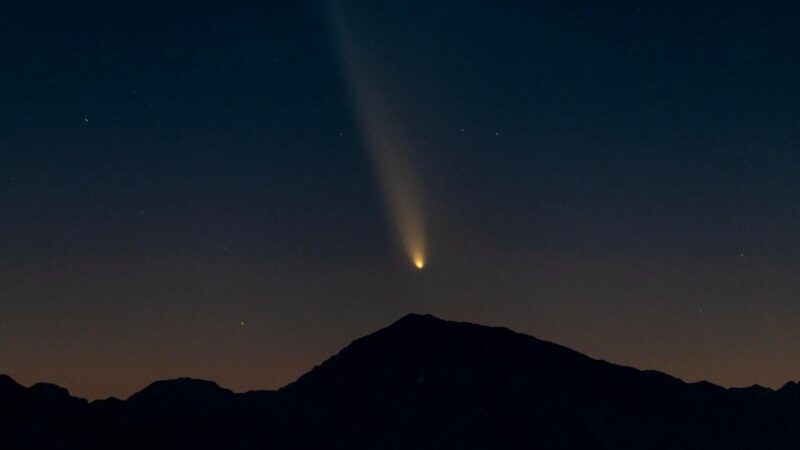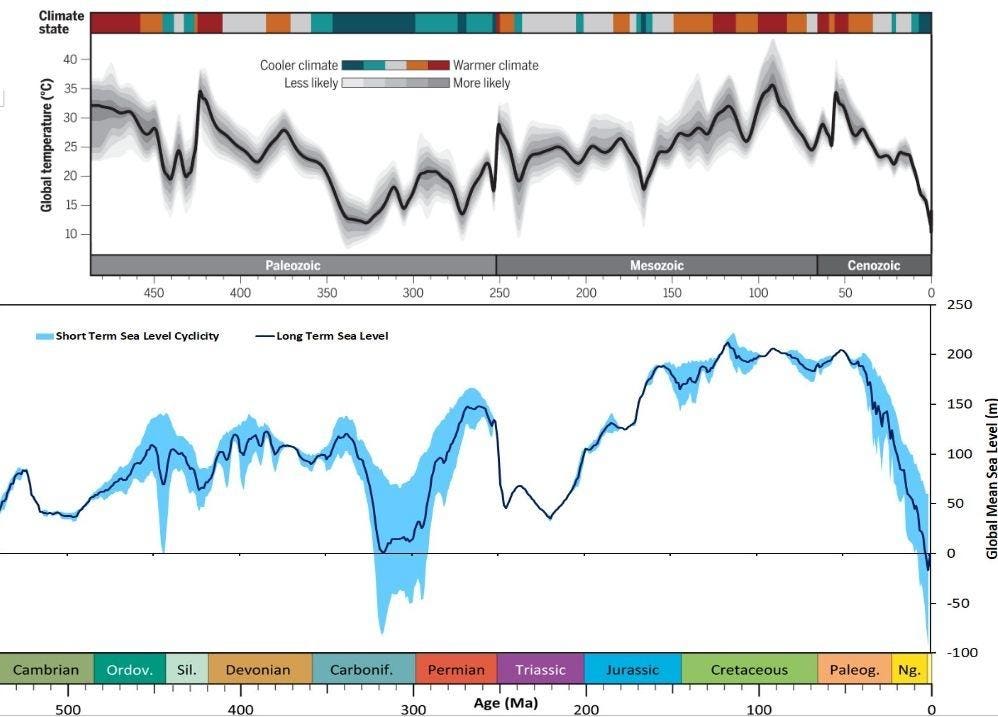Topline
Comet Lemmon — also called C/2025 A6 (Lemmon) — will on Thursday, Oct. 16, 2025, shine close to a bright star, making it the best opportunity so far to get eyes-on with a bright comet. The star, Cor Caroli, can be easily found close to the Big Dipper, one of the most famous shapes of stars in the night sky. There may also be a chance to find Comet SWAN — C/2025 R2 (SWAN) — in the southwest after sunset.
Comet Tsuchinshan-ATLAS appears over the Eastern Sierra mountains as it transitions into the evening sky shortly after sunset, as seen from the Ancient Bristlecone Pine Forest area, on October 12, 2024 near Big Pine, California. (Photo by David McNew/Getty Images)
Getty Images
Key Facts
On Thursday, Oct. 16, 2025, Comet Lemmon will be visible both after sunset and before sunrise close to the Big Dipper, with the best time to look about 90 minutes after dusk.
Comet Lemmon is rapidly approaching Earth, but there is no danger. At its closest on Tuesday, Oct. 21, it will still be 55.4 million miles (89.2 million kilometers) from Earth.
Comet Lemmon was discovered on Jan. 3, 2025, by the Mount Lemmon Survey near Tucson, Arizona. Astronomers have since calculated that it takes around 1,350 Earth-years to complete one orbit of the sun, but its close pass to Jupiter on the way into the inner solar system this year has saved some of its energy, according to Space.com, causing its orbit to reduce to 1,150 years.
An easy way to find the location of the comets is to use the finder charts at In-The-Sky.com or stargazing apps such as Sky Guide, Stellarium and SkySafari.
Comet Lemmon can be seen before dawn on Oct. 16 — the best time will be 5:39-6:09 a.m. EDT.
Stellarium
When And Where To See The Comets
The best time to spot Comet Lemmon and Comet SWAN on Thursday, Oct. 16 is during a 30-minute window starting about 90 minutes after sunset where you are. Both are visible after sunset but in opposite parts of the sky — Lemmon in the northwest, SWAN in the southwest. For New York City, where sunset is at 6:11 p.m. EDT, the ideal time for evening viewing is 7:41-8:11 p.m. EDT.
Comet Lemmon can also be seen before dawn. Look during a 30-minute window beginning about 90 minutes before sunrise. With sunrise at 7:09 a.m. EDT in New York, the best time will be 5:39-6:09 a.m. EDT — though earlier observations may also reveal the comet rising in the northeast.
The best time to see Comet Lemmon on Oct. 16 will be 90 minutes after sunset.
Stellarium
How To Find Comet Lemmon
Distance from the sun: 69.6 million miles (111.9 million kilometers)
Distance from Earth: 58.8 million miles (94.6 million kilometers)
Green comet Lemmon is now moving across about four degrees of the night sky each day, and is currently in the constellation Ursa Major — home to the Big Dipper.
Before sunrise, the comet is visible in the northeast. The Big Dipper’s handle will point down to the horizon. Look to the right side of stars Alkaid and Mizar at the end of the handle and you’ll find Lemmon just above the stars Cor Caroli in the simple two-star constellation of Canes Venatici. From New York, it will stand about 16 degrees high — approximately the span of your outstretched hand — at 5:39 a.m. EDT, as Venus rises due east, and climb higher as dawn approaches.
After sunset on Thursday, Oct. 16, look for Comet Lemmon just below the curved handle of the Big Dipper. It will be to the upper-left of Cor Caroli in Canes Venatici. Its height above the horizon varies by location, but from New York it will appear about 11 degrees above the northwest horizon at 7:41 p.m. EDT — roughly the width of four fingers held at arm’s length — and will gradually sink as twilight deepens.
The best time to see Comet SWAN on Oct. 16 will be 90 minutes after sunset.
Stellarium
How To Find Comet Swan
Distance from the sun: 85.4 million miles (137.5 million kilometers)
Distance from Earth: 25 million miles (40.3 million kilometers)
Blueish-green Comet SWAN — only discovered in September — will be visible in binoculars on Thursday, Oct. 16, 2025, low in the southwest after sunset. SWAN will be above the famous “Teapot” asterism in the constellation Sagittarius, and below the famous “Summer Triangle” of three bright stars. The comet will be in front of the Milky Way, so expect dense starfields to be visible behind the comet in binoculars. From New York it will appear about 24 degrees above the northwest horizon at 7:41 p.m. EDT.
How To Find Cor Caroli And The Comet
Comet Lemmon will be found very close to Cor Caroli, a double star about 115 light-years from the sun whose name means “Charles’ Heart.” To find it, locate the seven stars of the Big Dipper in the northern sky. At the end of the handle is Alkaid. Look to the side of Alkaid — about the same distance as the handle is long — and you’ll come to Cor Caroli. It is said to have shone brightly on the night King Charles II returned to England on May 29, 1660, to restore the monarchy after the English Civil War.
How Bright Are The Comets?
The Comet Observation Database reports Comet Lemmon to be shining at magnitude +5.2 and Comet SWAN a little dimmer at magnitude +5.9. Both have increased significantly in the last few nights, but they are not quite bright enough to be seen with the naked eye.
To see either comet, for now, you’ll need a pair of 8×42 or 10×50 binoculars, or similar, with Comet Lemmon the easiest to see. They will appear as diffuse patches of light, with locations far from streetlights and urban light pollution giving you the best views.
Check my feed every day this month for a daily “comet tracker” with finder charts and tips for viewing Comet Lemmon from mid-northern latitudes.








